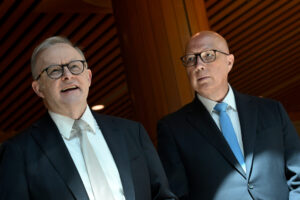Budget 2016 Wrap Up
Welcome to The Australia Institute’s 2016 Budget Review.
Firstly, the good news. No, really! In the space of one election cycle superannuation tax concessions went from bi-partisan sacred cow, to bi-partisan race to reform. The Australia Institute has put out a stack of reports calling for an overhaul of what has become one of Australia’s most expensive tax breaks. The changes announced by the Treasurer last night don’t go as far as we have recommended, but it’s a step in the right direction, and we welcome it.
Scott Morrison declared that this ‘is not an ordinary budget, it’s an economic plan’. We’ve seen a lot of budgets, and if we had to write the dictionary definition of a budget it would probably be: ‘An economic plan’. Sorry Scott, this is just another budget. It’s full of choices; like the choice to spend less on health and education; and the choice to give high income earners a tax cut; to cut funds from renewable energy but continue to subsidise the fuel bill for miners.
50 Prominent Australians recently signed an open letter calling on the Prime Minister to not cuts taxes and services in this budget. The government certainly was reluctant to give business what it wanted, pushing almost all of the big business tax cuts into budgets years down the road. This intervention should be congratulated for pushing back against the drum beat from the big business lobby for wholesale cuts to the corporate tax rate.
We’re not going to try to sum up last night’s budget with a snappy phrase (we’ll leave that to Richard). Instead, see below analysis of the impacts and assumptions, as well as the politics which makes up this ‘economic plan’. The Australia Institute’s budget wrap includes analysis from Richard Denniss, Matt Grudnoff, Dave Richardson and Tom Swann. We’re also eager to hear from you and happy to answer your questions about the Budget. Below:
- The Trickle-Down Budget
- Company Tax Cuts: Trickle or Treat
- MIA: What’s not hot according to Scott
- Groundhog Day: Why the ‘Path to Surplus’ is always 4 years away
- Say Jobs and Growth one more time
The ‘trickle-down’ budget
By Richard Denniss, Chief Economist
The two big tax cuts in the budget are based entirely on econobabble. There is no economic reason to believe that cutting the tax rate paid by small business will increase investment or employment. And there is no reason to believe that cutting taxes for people earning over $80,000 per year will make anyone work harder. What makes this ‘plan’ all the more remarkable is that it is hard to see how it will even win the government a lot of votes.
Let’s examine the tax cut for high income earners.
While it is apparently not polite to admit it these days, people who earn more than $80,000 per year are doing quite well by community standards. The average full-time male earns $87,840. But conflating average full-time males with the ‘average Australian’ is like describing the average height of Australians based on the average height of the Australian mens basketball team.

Leaving the statistical sophistry aside, the economic argument for the tax cut for the highest 25 per cent of income earners is equally dubious. The idea that full time male workers will quit their jobs or work fewer hours if they get a pay rise that tips them from the 32.5 per cent marginal tax rate to the 37 per cent tax bracket is absurd. If the government was at all concerned with using the tax system to encourage greater labour force participation it would be trying to help parents (mainly women) to re-enter the workforce after having kids.
The economic case for the small business tax cuts is equally dubious. This is a trickle-down budget in ‘growth dividend’ clothing.
Company Tax Cuts: trickle-down or treat?
By Dave Richardson, Senior Research Fellow
The government has a ten-year plan for cutting company tax cuts for businesses eventually ending up with a 25 per cent company tax rate in the year 2026-27. That’s a very long time in Australian politics.
By 2019-20, the company tax cuts will cost $950 million; the company tax rate for big business will remain unchanged at 30 per cent, while the small business company tax rate will have fallen to 27.5 per cent from 28.5 currently. But the definition of small business will blow out to those with a turnover of $100 million – up from $2 million at the moment.
$950 million a year is a light hit to revenue when compared with the ticking time-bomb set to go off in 2026-27. By then the annual cost of the tax cuts will be $19.7 billion, according to TAI estimates. Some of that will return to domestic shareholders (through the reduction in franking credits recieved) but there will nevertheless be a massive annual cost to cut the company tax rate.
The government has ignored the evidence that company tax cuts have not been associated with superior economic performance among overseas countries, or compared with Australia’s own history. In the meantime we know that much of the benefit goes to the top 15 listed companies such as the Commonwealth Bank which would make some $600 million now from a cut in the company tax cut and probably around a billion in 2026-27. The big four banks alone would receive almost a quarter of the total benefit by year 10. It’s a tiny trickle-down cut today, which would have to become Niagara Falls in the later years.
Missing In Action: What Scott Forgot
Climate Denied: by Tom Swann, Researcher
For a budget which purports to be about managing the transition post-mining boom, the absence of renewables was conspicuous. Even the Budget website makes the point. The form letting you browse the Budget based on your interests overlooks the fact that your possible ‘interests’ may include clean energy, climate change, or any of the environmental challenges the country is facing. And while Morrison made no mention of these issues in his speech, the budget reads as a hit-list for environmental and climate programs.
The Budget confirms previously announced funding cuts from the Australian Renewable Energy Agency (ARENA) which funds clean energy innovation. Now ARENA will manage a ‘Clean Energy Innovation Fund’ taken out of existing funds (from the Clean Energy Finance Corporation). Labor took the opportunity of Budget-eve to dump the news they will support this move, citing the lack of push back to the government’s plans from climate or clean energy advocates. The Greens pushed a motion trying to draw Labor’s support for ARENA, but they instead joined the Coalition to vote it down. It must be said however, that Labor, unlike the Coalition, has committed to a 50% renewable energy target.
The Budget also confirms previously announced plans to wind down the Climate Change Authority, which provides independent advice on what Australia should be doing. There is no new money for the Emissions Reduction Fund, and total climate spending reaches a whooping… 0.3% of total spending. Many other existing environmental programs are topped up out of existing funds or see small adjustments.
The Quietest Tax Cut Ever? – Matt Grudnoff
There were two personal income tax cuts in this year’s budget. One the Treasurer was happy to talk about, and one he wasn’t. How can this be? A Treasurer declining to boast about a tax cut?
While Morrison was happy to talk about his cut of $4 billion tax cut for the top 25 per cent, he was less keen to talk about the other big income tax cut: allowing the budget repair levy to lapse. This will see those earning more than $180,000 get a cut of two per cent in their income rate. Information about this was nowhere to be found in the budget papers. This is surprising since its worth more than the bracket creep tax cut, coming in at a $5.6 billion over the forward estimates.
Only 5 per cent of tax payers will get any benefit of this tax cut. But the top one per cent will get a tax cut of more than $12,000, or more than a grand a month.
If we look at the benefit of both tax cuts in 2017-18 we see that 75 per cent of the benefit goes to the top 10 per cent of tax payers and half (47%) goes to the top 1% of tax payers.
The graph below shows the dollar benefit of tax cuts in this budget for all Australian taxpayers by income, from the lowest 1% through to the highest 1%. As you can see, there is nothing in this budget for most Australians. There is some benefit to those earning over $80,000, but most goes to those on $180,000 or more.
Morrison’s Tax Cuts – Who Benefits (the top 1%)

Big call to do nothing on Negative Gearing – Richard Denniss
Central to the Government’s strategy seems to be the belief that because more than a million Australians negatively gears an investment property any proposal to reduce the generosity of negative gearing is political suicide. I don’t get it. Leaving aside the fact that the vast majority of people don’t negatively gear property investments, many of those who do can see the problems with the system more clearly than most.
The idea that voters always vote with their ‘hip pocket’ in mind is not well founded. Indeed, if it was, then why would Australians who don’t build submarines and/or live in Adelaide think that spending $50 billion on submarines is a good idea? Of course Australians vote with their interests in mind, but their interests clearly extend to concerns with national security, job security and environmental protection. Some voters who negatively gear might even think about their children’s hip pockets and the fact that our tax system has helped make Australian housing among the most expensive in the world. Bizarrely, the same government that wants voters to worry about the impact of government borrowing on future generations is betting that voters don’t care whether the next generation can afford to buy a house. That’s a big call.
Deregulation deferred but not forgotten? – Tom Swann
Morrison didn’t mention higher education last night either, but the Education Minister Simon Birmingham’s big move is to back away even further from the political shambles Christopher Pyne’s policies created.
While there are cuts to equity access programs, the government pushed back another year the 20% cuts to funding, and has shelved the ‘efficiency dividends’ (introduced by Labor and then dumped from opposition).
The big news is that plans for university deregulation have finally been taken out of the budget. Ironically, that saves the government $2bn. In place of deregulation, Birmingham has released a ‘discussion paper’ – Driving innovation, fairness and excellence – and called for feedback, due two weeks after the election. However, the options in the discussion paper make clear the government is looking to cut costs and increase fees, including fee deregulation for a limited range of degrees at each university.
Deregulation was always at dubious policy, with serious risks of fee inflation that would see students pay more to fund research. But the government is no doubt thinking more of the politics. As our research showed, only one in six people think deregulation would be good for educational quality, and most people think there should be more government investment.
The Budget also attempts to neutralise the issue of school funding, after Turnbull suggested the Commonwealth would get out of funding public schools, with $1.2bn in new needs-based funding in 2018-2020. But this remains problematic: it is still a massive cut from the $4.5 billion required under the ‘Gonksi’ needs based plan.
Groundhog day: Why the “credible path to surplus” is always just 4 years away
By Matt Grudnoff, Senior Economist
Those who watch the budget every year will see a pattern emerge. Each year we see predictions that the deficit will fall, and each year those predictions don’t come true. But every year, the forward estimates predict a ‘path to surplus’… again.
The government predicts that in 2016-17 the budget deficit will be $37.1 billion. Just two years ago they predicted the budget deficit would be $10.6 billion. Whoops. But that $10 billion deficit hasn’t disappeared, it’s just caught in a time warp.
If we look at the government’s last three budget deficit predictions we can see the path to surplus keeps moving out one year. Every year. It’s surplus Groundhog Day (or year). In the graph below, you can see that the ‘Path to Surplus’ each year looks just like last years, but a year older.
Figure 1. The ‘Path to Surplus’ – always just 4 years away.

We’re all being led down a path, but it’s looking more like the garden variety than a credible path to surplus.
And just to help you through the next 7 weeks…
Between the Lines Newsletter
The biggest stories and the best analysis from the team at the Australia Institute, delivered to your inbox every fortnight.
You might also like
Just what I’ve always wanted! How pretending to like gifts will cost Australians over $1 billion this Christmas
Do you relish the look of joy and surprise on the faces of loved ones when they open your Christmas presents?
What kind of country do you want? | Between the Lines
The Wrap with Amy Remeikis What Peter Dutton and the Coalition are offering Australian voters is a fiction. It’s headlines without substance, chimeras and half-truths that never stand up to scrutiny, but comprehensively misdirects the media’s gaze. The nation has been in election mode since the beginning of the year, when Anthony Albanese used his
Now that there are no safe seats – the ‘bellwether seat’ is no more.
Media analysis shows that the decade from 2007 was the bellwether era, but that era has now passed




